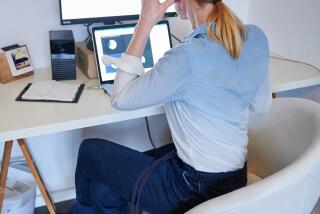Pedometers nudge people to walk more
Pedometers have become popular tools for keeping track of steps and promoting moderate exercise. Now theyâve been used to get inactive people moving as well as to discover how few steps college kids take each day.
In a University of Minnesota study examining the effectiveness of giving inactive patients pedometers, 94 participants were given a brief talk by a physician on the importance of exercise, a one-page handout detailing the same, and three follow-up phone calls from a health educator. About half were given a pedometer and asked to increase their steps by 400 each week. They were also told to keep a record of their daily steps.
After nine weeks, both groups had walked more and incorporated more physical activity into their daily lives. Those with pedometers (21 of the 50 kept adequate logs) increased their steps by about 2,100 (from 6,700 to 8,800 a day) or about 20 minutes of walking. This group upped its activity slightly more than those in the control group, which also âsignificantly increased their amounts of physical activity,â said lead researcher Dr. Steven Stovitz, an assistant professor of family medicine. Pedometers, he said, appear to serve as a constant reminder of how many steps patients were taking.
The findings are inspiring, said Stovitz, who conceived the idea after being frustrated with truncated patient visits that didnât allow enough time to properly counsel the out-of-shape on ways to be more active. By offering education, motivation and a tool to track their progress, he said, change is possible.
âThis is encouraging news,â Stovitz said. âWe need to get the message across however many ways we can. Certainly most patients wonât follow recommendations to increase their physical activity, but it doesnât mean that we, as physicians, should be any less persistent.â
He presented his findings this month at the American College of Sports Medicineâs annual meeting in Indianapolis. The college is an Indianapolis-based institution devoted to sports medicine and exercise science.
Also presented at the meeting was a study that used pedometers to count the steps of 79 students at Oklahoma State University.
Lead researcher Becky Wilber, then a masterâs degree candidate, found that undergrads averaged about 7,700 steps a day, far short of the recommended 10,000 steps a day. They were way behind children ages 6 to 12, who average 11,000 to 13,000 steps a day.
Although we think of college students as walking or biking to, from and on campus, Wilber said thatâs not always the case.
âI noticed that students would be dropped off on campus by their friends,â she said, âand after class theyâd get on their cellphones and call to be picked up,â even if they lived just off campus. Though Wilber said the campus is compact -- she estimated it to be about two miles square -- and building-to-building walks can take about 10 minutes, students are opting for car rides instead.
Computers may be culprits as well. Students can do research from their homes or dorm rooms instead of having to make the trek to the campus library.
She said she hoped the study, done last year, would make students aware of their need to be more physically active. Changes such as walking instead of driving, Wilber said, are painless ways to incorporate more movement. âPeople are not going to know how to change their lifestyle until you educate them.â




